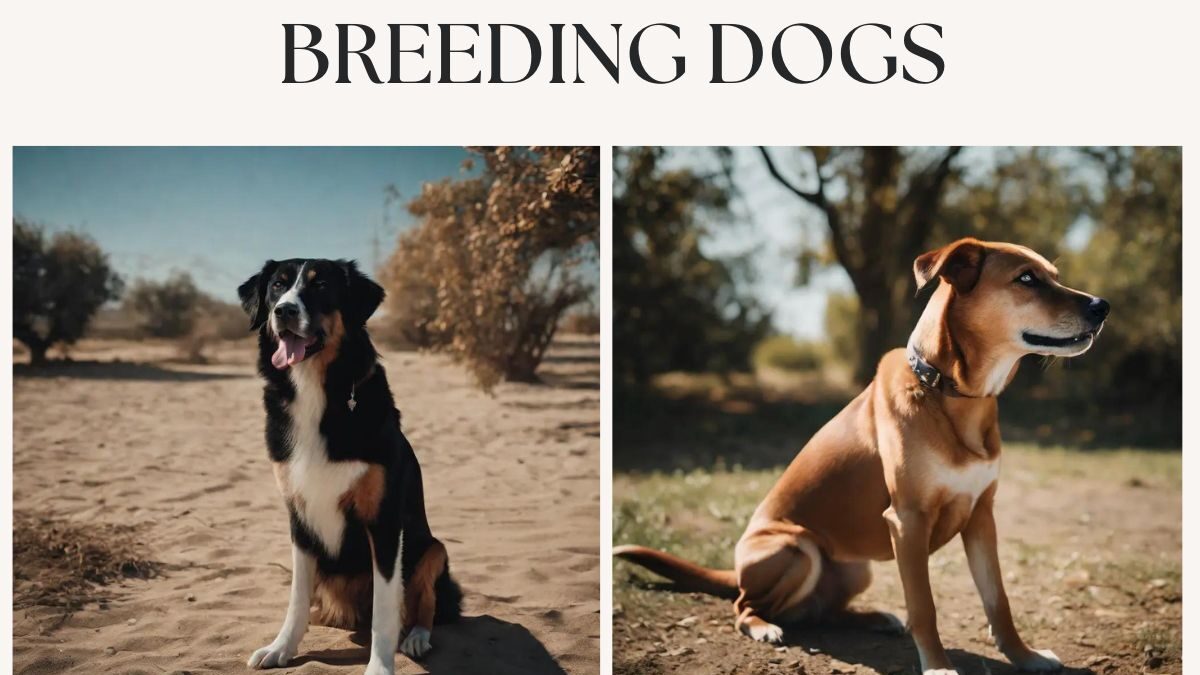
Table of Contents
Introduction
Retired breeding dogs symbolize a significant and transformative milestone in their lives, representing a profound shift from their once-demanding roles in the breeding industry to a peaceful and cherished phase as beloved family pets. This transition holds valuable insights into the diverse array of scenarios that these remarkable canines encounter once they retire from their breeding duties. It is an intriguing and heartwarming exploration of their journey, which encompasses the profound transformation from dutifully fulfilling their purpose in the world of breeding to wholeheartedly embracing a life replete with abundant comfort, unwavering love, and newfound freedom.
Upon retirement, these extraordinary dogs embark on a path that varies depending on their individual circumstances. Some are fortunate enough to be adopted by their handlers or breeders, allowing them to seamlessly transition into a loving and familiar environment. For these fortunate canines, retirement signifies a continuation of the bond they have formed with their caretakers, as they now have the opportunity to enjoy a well-deserved life of leisure, companionship, and undivided attention.

However, not all retired breeding dogs are fortunate enough to remain with their handlers or breeders. In some cases, these dedicated canines are placed in adoption programs or rescue organizations that specialize in finding them forever homes. This transition can be both exciting and challenging for these dogs as they adapt to new surroundings, routines, and caregivers. Yet, their resilient spirits and capacity for unconditional love often enable them to forge deep connections with their new families, bringing immeasurable joy and fulfillment to both sides.
What is a retired dog?
A retired dog refers to a canine companion that has completed its active service or primary role, transitioning from its former responsibilities into a phase of relaxation and companionship. In the context of this discussion, a retired dog specifically pertains to a breeding dog that has fulfilled its duties within the breeding industry. These dogs have typically completed a certain number of breeding cycles or have reached a specific age where they are no longer utilized for breeding purposes. This transition marks a significant shift in their lives, as they move away from the demands of reproduction and enter a phase of retirement, where they become cherished pets in loving homes.
Retired breeding dogs, also known as retired breeder dogs, retired breeder dogs for adoption, or retired breeding dogs for adoption, signify canines who have dedicated a portion of their lives to the breeding industry. They have contributed to the lineage of their breed but have now reached a stage where they are no longer actively involved in breeding. Instead, these dogs transition into a serene phase as beloved pets, enjoying the comforts of a loving household. This transition offers them respite from the rigors of breeding, allowing them to relish a stress-free life and fostering deeper connections with their adoptive families. Adoption provides these retired breeding dogs with a new lease on life, where they can thrive in a caring environment, bringing joy and companionship to their new homes.
Different Scenarios for Retired Breeding Dogs
1. Transition from Work
– Military or Police Dogs
Military or police dogs, renowned for their exceptional training and unwavering dedication, inevitably face retirement as they reach a certain age or encounter physical limitations that hinder their active service. This significant transition marks the beginning of a new chapter in their lives, one that revolves around finding suitable homes where they can enjoy a well-deserved and peaceful retirement.
The retirement process for these remarkable canines involves careful consideration and planning. Handlers and organizations responsible for their well-being prioritize their comfort and overall quality of life. In many cases, handlers who have formed deep bonds with their canine partners are given the opportunity to adopt them into their own homes. This continuation of the handler-dog relationship allows for a seamless transition into retirement, as the dog remains in a familiar and loving environment where they can continue to thrive.
– Sporting Dogs
Sporting dogs, once stars of agility or obedience competitions, may retire due to aging or the i
Sporting dogs, esteemed for their agility, intelligence, and remarkable performance in various competitive arenas such as agility or obedience competitions, eventually reach a point where retirement becomes necessary due to the natural progression of aging or the physical limitations that prevent them from continuing their competitive careers. This transition from the intense and demanding world of sports to a tranquil and relaxed existence as cherished household pets brings about a profound sense of calmness and contentment for these remarkable canines.
Throughout their active years in the competitive realm, sporting dogs dedicate themselves to rigorous training, intricate routines, and thrilling performances that captivate audiences. They showcase their innate abilities, incredible athleticism, and unwavering focus, often earning accolades and recognition for their exceptional skills. However, as time passes, their bodies may start to show signs of wear and tear, and they may encounter limitations that prevent them from performing at their peak.
When the time comes for retirement, these remarkable dogs embark on a new journey, transitioning from the high-stress and demanding nature of competitive sports to a more serene and relaxed lifestyle within a loving household. The transition brings with it a sense of relief and freedom from the pressures of competition, allowing them to savor a well-deserved respite and enjoy a slower pace of life.
– Breeding Dogs
Breeding dogs, having fulfilled their responsibilities of producing designated litters or reaching a specific age that signals the end of their breeding careers, gracefully transition into a new phase of life, where they are welcomed into the warm embrace of loving families. Their days of tirelessly contributing to the propagation of their breed are replaced with the immense joy of simply being cherished pets, relishing in the comfort, care, and undivided attention they rightfully deserve.
Throughout their breeding years, these exceptional canines have played a crucial role in perpetuating their breed’s lineage, passing on desirable traits and maintaining the breed’s integrity. They have diligently undergone reproductive cycles, undergone health screenings, and undergone the physical demands of pregnancy and nursing. However, as their breeding days draw to a close, they are ready to embrace a life free from the demands and responsibilities of reproduction.
Retired breeding dogs find solace in the loving arms of their adoptive families, who recognize the invaluable contributions these dogs have made to their breed and are eager to provide them with the life they truly deserve. These families understand the unique needs of retired breeding dogs and are committed to ensuring their well-being and happiness in their post-breeding phase.
In their new role as beloved pets, retired breeding dogs experience the simple pleasures of life. They relish in leisurely walks, cozy snuggles, and playtime that is solely for their enjoyment. Their days are filled with the love and companionship of their human family members, who shower them with affection, attention, and the comforts of a safe and nurturing home environment.

2. Show Dogs in Retirement
Exiting the competitive circuits, show dogs transition into cherished pets, finding solace with either breeders or new owners. Their well-socialized nature and calm temperaments make them perfect companions, thriving in tranquil environments.
Pros of Adopting Retired Breeding Dogs
– Health and Well-being
Ceasing their breeding responsibilities contributes to reduced stress and health issues associated with reproduction. This change ensures a healthier and potentially longer life for retired breeding dogs. Their post-retirement phase is marked by a peaceful and stress-free lifestyle, enhancing their overall well-being.
– Temperament and Training
Retired breeding dogs come with a unique advantage of enhanced maturity and socialization gained through their training experiences. These qualities make them valuable companions, displaying well-behaved and calm dispositions. Their adaptability and calm nature make them ideal for families, fostering strong bonds and trust.
– Socialization and Bonding
The process of adopting retired breeding dogs nurtures deep emotional connections, empowering adopters and ensuring a smooth transition into loving forever homes. Gradual transitions, along with quality time spent, assist these dogs in integrating seamlessly into new family environments, fostering a safe and affectionate atmosphere.
Cons of Adopting Retired Breeding Dogs
– Health Concerns
One potential drawback involves managing hereditary health conditions that retired breeding dogs might pass on to their progeny. This consideration necessitates specialized care requirements, demanding patience and understanding to help these dogs adjust to their new lives. While many retired breeding dogs enjoy good health, it’s essential to be prepared for possible health issues that may arise.
– Behavioral Challenges
Difficulties in adapting to a new home environment can arise due to their previous experiences. Patience and positive reinforcement during the transition period are crucial for addressing potential behavioral challenges. Past experiences may impact their behavior, requiring adopters to handle these issues with care and compassion, allowing these dogs to thrive in their new environment.
– Transition and Adjustment
Time and effort play pivotal roles in aiding these dogs’ adjustment to their new lifestyle. Consistent routines and a caring atmosphere are essential for their comfort. Resistance to change due to established routines might pose challenges, demanding gradual adaptation strategies and patience from adopters, ensuring a smooth transition into their new homes.
Considerations Before Adopting
– Questions to Ask
Before adopting a retired breeding dog, certain essential questions need addressing:
1. Has the dog been spayed or neutered?
Reason: Knowing whether the dog has been spayed or neutered is crucial for multiple reasons. It helps prevent unintended breeding and contributes to the dog’s overall health and behavior. Spaying or neutering can also reduce the risk of certain health issues and behavioral concerns.
2. What is the dog’s history and previous living conditions?
Reason: Understanding the dog’s past helps assess its adaptability to a new environment. Information about its previous living conditions, such as socialization, routines, and interactions, can provide insights into potential behavioral patterns and help in creating a suitable environment for the dog’s transition.
3. Are there any known behavior issues that need attention?
Reason: Awareness of any existing behavior issues allows adopters to prepare adequately. It facilitates a proactive approach in addressing these issues, whether through training, behavioral therapies, or creating a supportive environment. Being informed helps manage and improve the dog’s behavior effectively.
4. Are there any existing medical conditions or special care requirements?
Reason: Knowledge of any medical conditions or special care needs is crucial for the dog’s well-being. It enables prospective adopters to provide the necessary care, medication, or accommodations the dog might require. Understanding these conditions ensures proper management and a comfortable life for the dog.
5. Where can retired breeding dogs be found for adoption, and what is the usual age range and adoption cost?
Reason: Knowing where to find retired breeding dogs for adoption helps potential adopters connect with reputable sources or organizations. Understanding the usual age range and adoption costs assists in planning and aligning expectations. This information aids in making informed decisions about the adoption process, ensuring a smooth transition for both the dog and the adopter.
These questions serve as vital checkpoints, ensuring that potential adopters gather essential information to create a suitable and nurturing environment for the retired breeding dog they intend to welcome into their homes.
Reasons for Adopting Retired Breeding Dogs
Retired breeding dogs have dedicated a substantial part of their lives to supporting breeding programs and ensuring the continuity of their lineage. As they reach their retirement phase, offering them a loving home becomes not just a gesture of kindness but a vital aspect of their well-being. Providing a nurturing environment in a loving household fulfills their need for companionship and care after their years of service. It’s an opportunity to show gratitude for their contributions by offering them a peaceful sanctuary where they can thrive emotionally and physically. Each retired breeding dog deserves a chance to enjoy the comforts of a caring home, where they can form strong bonds and receive the attention they richly deserve.
Adopting retired breeding dogs isn’t just about offering them a home; it’s a mutually beneficial relationship. For these dogs, adoption signifies the start of a peaceful retirement, free from the responsibilities of breeding. They transition from a regulated environment to the warmth of a home, experiencing a life focused on love and comfort. Conversely, for the adopter, welcoming a retired breeding dog into their life brings the joy of companionship and loyalty. These dogs often come with a wealth of training and socialization, making them wonderful, well-mannered companions. Their calm temperament, coupled with their maturity, makes them ideal pets, offering a sense of fulfillment to the adopter. The bond formed with a retired breeding dog often surpasses expectations, resulting in a devoted and loving relationship that enriches both lives.
Check out: Can Dogs Eat Cake Frosting?
Conclusion
Understanding the nuances of adopting retired breeding dogs enables individuals to make informed decisions about bringing these loving companions into their homes. It’s a journey that requires compassion, patience, and a willingness to provide a comfortable and nurturing environment for these dogs as they embark on their well-deserved retirement.


Why is My Dog’s Mouth Cold? Possible Reasons Every Pet Owner Should Know - Pawsgal
[…] Pros and Cons of Retired Breeding Dogs: A Comprehensive Guide Can Dogs Eat Cake Frosting? Complete Guide Dogs Prev post Pros and Cons of Retired Breeding Dogs: A Comprehensive Guide […]
Barking up the wrong tree: why beagles are the worst dogs? - Pawsgal
[…] Pros and Cons of Retired Breeding Dogs: A Comprehensive Guide […]
Can I Use Witch Hazel on my Cat? A Helpful Guide - Pawsgal
[…] Pros and cons of retired breeding dogs a comprehensive guide […]
How Much Longer until Your Pregnant Cat’s Kittens Start Moving? - Pawsgal
[…] Pros and cons of retired breeding dogs a comprehensive guide […]
Can Cats Eat Dragonflies?: A Quick Guide - Pawsgal
[…] Pros and cons of retired breeding dogs a comprehensive guide […]
Can Cats Eat Teriyaki Chicken or Not? - Pawsgal
[…] Pros and cons of retired breeding dogs a comprehensive guide […]
Why Do Cats Love String So Much? - Pawsgal
[…] Pros and cons of retired breeding dogs a comprehensive guide […]
Cat Sleeping Positions : What Do They Mean - Pawsgal
[…] Pros and cons of retired breeding dog sa comprehensive guide […]
Can Cats Eat Sesame Oil? A Comprehensive Guide Pawsgal
[…] Pros and cons of retired breeding dogs a comprehensive guide […]